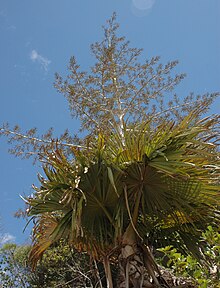Tahina spectabilis
| Tahina spectabilis | |
|---|---|
 |
|
| Scientific classification | |
| Kingdom: | Plantae |
| (unranked): | Angiosperms |
| (unranked): | Monocots |
| (unranked): | Commelinids |
| Order: | Arecales |
| Family: | Arecaceae |
| Subfamily: | Coryphoideae |
| Tribe: | Chuniophoeniceae |
| Genus: |
Tahina J. Dransf. & Rakotoarinivo, 2008 |
| Species: | T. spectabilis |
| Binomial name | |
|
Tahina spectabilis J. Dransf. & Rakotoarinivo, 2008 |
|
Tahina spectabilis, the tahina palm, is a species of gigantic palm that is found only in the Analalava District of northwestern Madagascar. It can grow 18 m (59 ft) tall and has leaves over 5 m (16 ft) across. An individual tree was discovered when in flower in 2007; it was first described the following year as a result of photographs being sent to Kew Gardens in the United Kingdom for identification. The palm is thought to live for up to fifty years before producing an enormous inflorescence and subsequently dying. Fewer than one hundred individuals of the species are thought to exist and the International Union for Conservation of Nature has rated it as "critically endangered".
The species, which produces countless flowers and (after fruiting) dies, is sufficiently different from other known palms to justify the creation of the monotypic genus Tahina, which is now included with three other genera in the tribe Chuniophoeniceae; the other members being found in the Arabian peninsula, Thailand and China. Fewer than one hundred individuals of the species are thought to exist.
The palm is the largest of the 170 palm species native to Madagascar, having a trunk up to 18 m (59 ft) tall and leaves which are over 5 m (16 ft) in diameter.
Tahina spectabilis normally appears much like other palms. However, when it flowers, which John Dransfield of the Royal Botanic Gardens, Kew estimates as occurring after every 30 to 50 years, the stem tip grows a large inflorescence that bursts into branches of hundreds of flowers. The drain on nutrients this display entails results in the death of the organism within several months.
The tahina palm was discovered by French cashew plantation manager Xavier Metz and his family, who were strolling through a remote northwestern region of Madagascar in 2007 when they came across a flowering individual and sent photos to the Kew Gardens for identification.
...
Wikipedia

